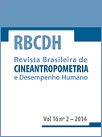Resposta cardiorrespiratória e gasto energético em exercício na máxima fase estável de lactato
DOI:
https://doi.org/10.1590/1980-0037.2014v16n2p212Resumen
A resposta cardiorrespiratória durante exercícios submáximos, na intensidade da máxima fase estável de lactato (MFELint) até a exaustão, tem sido pouco investigada. O objetivo deste estudo foi investigar a resposta do consumo de oxigênio (VO2), frequência cardíaca (FC) e pulso de oxigênio (pulso O2) em exercício realizado na MFELintaté a exaustão, e comparar o gasto energético (GE) estimado pelo VO2e pela FC. Doze sujeitos treinados realizaram um protocolo incremental em cicloergômetro para determinar parâmetros máxi-mos e submáximos do metabolismo aeróbio. Posteriormente, foram realizados 2 a 4 testes de 30 min com carga constante para identificar a MFELint. Finalmente, os sujeitos realizaram um teste até a exaustão na MFELint. Os parâmetros cardiorrespiratórios foram medidos continuamente durante todos os testes. No teste de exaustão, as respostas fisiológicas foram comparadas entre seis momentos relativos do tempo de exaustão (TTE). O TTE médio foi 55,1±10,2 min. O pulso de O2 apresentou reduções significativas ao longo do tempo, atingindo, no momento da exaustão, um valor ~ 9% inferior comparado ao início do exercício. Este fato ocorreu pelo aumento da FC ao longo do tempo de forma desproporcional ao aumento do VO2, resultando em diferenças significantes entre os GE estimados. Portanto, em exer-cício realizado na MFELint até a exaustão, parece existir uma perda gradual da eficiência cardiorrespiratória, evidenciada pela redução do pulso O2. Assim, a relação direta entre VO2e FC com a carga de trabalho é alterada ao longo do exercício, conduzindo a erros de estimativa do GE a partir dos valores da FC.
Descargas
Publicado
Número
Sección
Licencia

Direitos Autorais para artigos publicados nesta revista são do autor, com direitos de primeira publicação para a revista. Em virtude da aparecerem nesta revista de acesso público, os artigos são de uso gratuito, com atribuições próprias, em aplicações educacionais e não-comerciais, desde que seja dada a atribuição. Esta obra foi licenciada com uma Licença Creative Commons Atribuição 4.0 Internacional - CC BY


